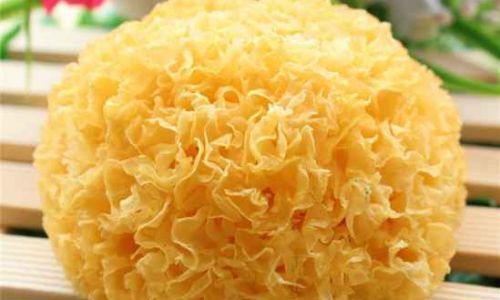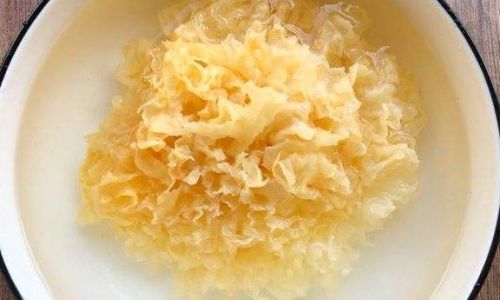Introduction
White fungus, scientifically known as Tremella fuciformis, is a popular edible mushroom cherished for its delicate texture and numerous health benefits. Often used in Asian cuisines, particularly in desserts and soups, white fungus boasts a high nutritional value, rich in dietary fiber, vitamins, and minerals. One of the essential steps in preparing white fungus for cooking is soaking it in water to soften it. However, once soaked, the question arises: how long can soaked white fungus be stored before it spoils? This article aims to provide a comprehensive guide on storing soaked white fungus, addressing various factors that influence its shelf life, storage methods, and signs of spoilage.
Understanding White Fungus and Its Preparation
Before diving into the storage aspect, it’s crucial to understand the basic preparation of white fungus. White fungus is typically sold in dried form, which preserves it for extended periods. When ready to use, the dried fungus needs to be soaked in water until it softens and expands to its original texture. The soaking process can take anywhere from a few hours to overnight, depending on the size and thickness of the pieces.

Factors Influencing the Shelf Life of Soaked White Fungus
Several factors determine how long soaked white fungus can be stored safely:
-
Quality of the Dried Fungus: The initial quality of the dried white fungus plays a significant role. High-quality, properly dried fungus will have a longer shelf life both before and after soaking.
-
Soaking Conditions: The temperature and cleanliness of the water used for soaking can affect the shelf life. Using clean, cold water is recommended to minimize bacterial growth.
-
Storage Conditions: Once soaked, the storage conditions—including temperature, humidity, and exposure to air—are crucial. Proper storage can significantly extend the shelf life.
-
Handling and Packaging: How the soaked fungus is handled and packaged after soaking also matters. Using clean utensils and airtight containers can help prevent contamination.
Storage Methods for Soaked White Fungus
There are several methods for storing soaked white fungus, each with its own set of pros and cons. Here’s a detailed look at each:
-
Refrigeration:
- Method: After soaking, drain the water and pat the fungus dry with paper towels. Place it in an airtight container or a zip-top plastic bag and store it in the refrigerator.
- Shelf Life: Soaked white fungus can be stored in the refrigerator for up to 3-5 days. The colder temperature slows down bacterial growth, preserving the fungus longer.
- Precautions: Ensure the container is airtight to prevent moisture and air from entering, which can promote spoilage.
-
Freezing:
- Method: For longer-term storage, soaking and draining the fungus as described above is necessary. However, instead of refrigerating, place the fungus in a freezer-safe container or zip-top bag, removing as much air as possible before sealing.
- Shelf Life: Frozen soaked white fungus can be stored for up to 3 months. Freezing further slows down bacterial and enzymatic activity, extending the shelf life.
- Precautions: Label the container with the date to keep track of how long it has been stored. When ready to use, thaw the fungus in the refrigerator overnight to avoid texture degradation.
-
Drying:
- Method: While not traditional for soaked white fungus, some people attempt to re-dry it to extend its shelf life. However, this method is not recommended as re-dried fungus may lose its texture and flavor.
- Shelf Life: If re-dried improperly, the shelf life is unpredictable and may be shorter than if stored refrigerated or frozen.
- Precautions: Avoid re-drying soaked white fungus unless absolutely necessary, as it often does not yield satisfactory results.
Signs of Spoilage in Soaked White Fungus
Identifying spoiled soaked white fungus is crucial to avoid food poisoning and maintain food safety. Here are some signs to look for:
-
Odor: Fresh, soaked white fungus should have a mild, earthy aroma. If it develops a strong, unpleasant odor, it is a sign of spoilage.

-
Color Changes: White fungus should maintain its light, translucent color after soaking. Discoloration, such as dark spots or yellowing, indicates spoilage.
-
Texture: Soaked white fungus should be firm yet tender. If it becomes slimy, mushy, or develops a sticky texture, it is a sign of bacterial growth.
-
Mold: Visible mold growth on the surface of the fungus is a clear indication of spoilage. Discard immediately.
Tips for Extending the Shelf Life of Soaked White Fungus
To maximize the shelf life of soaked white fungus, follow these tips:
-
Use High-Quality Dried Fungus: Start with high-quality, properly dried white fungus to ensure a longer shelf life.
-
Soak in Clean, Cold Water: Use clean, cold water to soak the fungus, and change the water periodically if soaking for extended periods.
-
Prompt Refrigeration or Freezing: After soaking, drain and dry the fungus thoroughly and store it in an airtight container in the refrigerator or freezer immediately.
-
Avoid Cross-Contamination: Use clean utensils and containers to handle and store the soaked fungus to prevent cross-contamination.
-
Inspect Before Use: Always inspect the soaked white fungus before use for any signs of spoilage.
Nutritional and Health Benefits of White Fungus
Beyond its shelf life and storage considerations, white fungus offers numerous nutritional and health benefits, making it a valuable addition to the diet. Here are some of its key benefits:
-
Rich in Dietary Fiber: White fungus is high in dietary fiber, which aids in digestion and promotes bowel health.
-
Low in Calories: It is a low-calorie food, making it suitable for weight management diets.

-
High in Antioxidants: Rich in antioxidants like polysaccharides, white fungus helps combat oxidative stress and inflammation.
-
Supports Immune Health: The polysaccharides in white fungus have immune-boosting properties, helping to strengthen the immune system.
-
Hydrating and Moisturizing: Its gelatinous texture makes it an excellent hydrating agent, beneficial for skin health.
-
Supports Cardiovascular Health: Preliminary research suggests that white fungus may help lower cholesterol levels and support cardiovascular health.
Recipes and Culinary Uses of White Fungus
White fungus is versatile and can be incorporated into various recipes, making it a delightful addition to any meal. Here are some popular culinary uses:
-
Soups and Stews: White fungus is often used in soups and stews, adding a silky texture and mild flavor.
-
Desserts: It is a key ingredient in many Asian desserts, such as white fungus soup with red dates and lotus seeds.
-
Salads: Its light texture makes it a suitable addition to salads, providing a unique crunch and hydration.
-
Stir-Fries: White fungus can be stir-fried with vegetables or meat for a nutritious and delicious dish.
-
Smoothies and Beverages: Its gelatinous texture can be blended into smoothies or used as a thickener in beverages.
Conclusion
In conclusion, soaked white fungus can be stored for several days when handled and stored properly. Refrigeration and freezing are effective methods for extending its shelf life, with each offering different advantages based on the intended use and storage duration. By understanding the factors that influence the shelf life of soaked white fungus and following best practices for storage and handling, you can enjoy its numerous nutritional and health benefits without worrying about spoilage. Remember to always inspect the fungus before use for any signs of spoilage to ensure food safety. With its delicate texture and myriad health benefits, white fungus is a valuable addition to any diet, making it worth the effort to store and prepare correctly.




0 comments